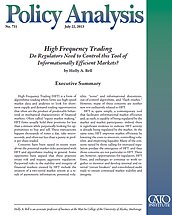Concerns have been raised in recent years about the potential market risks associated with HFT and algorithmic trading in general. Some opponents have argued that these practices create risk and require aggressive regulation. Purported risks to the stability and integrity of financial markets created by HFT include the creation of a two-tiered market system as a result of asymmetric information, potential volatility, “noise” and informational distortions, out-of-control algorithms, and “flash crashes.” However, many of these concerns are neither new nor exclusively related to HFT.
HFT is, quite simply, a contemporary tool that facilitates informational market efficiency and, as such, is capable of being regulated by the market and market participants—indeed, there is significant evidence to indicate HFT activity is already being regulated by the market. At the same time, HFT improves market efficiency by lowering the costs to investors, controlling volatility, and improving liquidity. Many of the concerns raised by those calling for increased regulation predate the emergence of HFT, and thus those concerns are not particular to HFT. There are, however, opportunities for regulators, HFT firms, and exchanges to continue to work together to monitor and develop internal and external “circuit breakers” and consolidated audit trails to ensure continued market stability and integrity.
